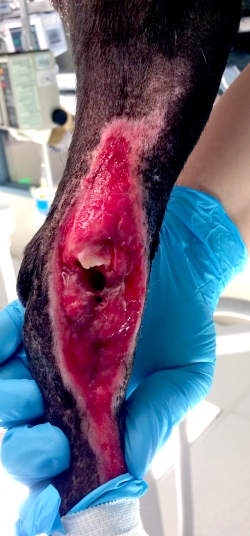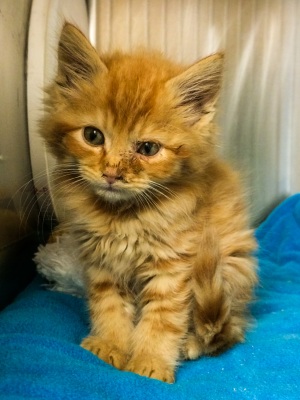Blog Archives
Lab Mix with Degloving Injury Gets Second Chance with Three Legs
When Chance first came into the San Jose Animal Care Center (SJACC), it was evident that his left hind leg was badly injured, reportedly after he was hit by a car. Chance had suffered a degloving injury, which means that the skin was missing from his leg, leaving the bones in that area exposed. To make things worse, the bones in the affected area of Chance’s leg were not attached and connected like they should be. The injury was gruesome, but Chance was otherwise in good health and spirits.
Veterinarians at SJACC made sure Chance was comfortable by giving him pain medications along with antibiotics to fight infection. The vets bandaged and splinted Chance’s leg and changed it daily while waiting for an owner to come to the shelter and claim him. The wet-to-dry bandages also served to clean out the wound from dirt, debris, and dead tissue, allowing fresh tissue to take over.
San Jose Shelter Pushes Forward and Strives to Save More Kittens Each Year
The summer is when kitten season is in full swing. Because cats are such prolific reproducers, animal shelters tend to become overrun with kittens during the summer months (or, more accurately, most of the year in California animal shelters). With such a high influx of kittens, it is often hard for shelters to keep up with them and the care they require.
Many shelters euthanize kittens under two pounds upon entering the shelter, even if they are healthy. You can imagine what the fate is for kittens that are not healthy. The San Jose Animal Care Center (SJACC) does not follow this practice. Rather, the SJACC has worked hard to save a higher percentage of kittens each and every year and has gradually decreased the weight at which the shelter’s veterinarians feel it is safe to perform surgery (using special protocols for these fragile mini-kitties) and adopt out kittens. As of 2014, the minimum weight kittens must be for surgery to be performed at SJACC is 1.3 pounds.
The Forensic Veterinary Examination
Perhaps one of the most unique aspects of my job as a shelter veterinarian at a large municipal shelter is that I get to be involved in veterinary forensics.
For those of you who have seen shows such as Animal Cops or CSI, you may have an idea of what this entails. Essentially, I work with animal service officers to investigate and prosecute cases such as animal abuse and neglect by performing examinations on the animals that are the focus of the investigation to determine whether my examination supports or fails to support the case.
Some of the interesting cases I’ve seen so far include:
- Dogs allegedly killed by other dogs
- Dogs that were allegedly abused.
- Dogs that were allegedly neglected, such as owners allegedly failed to provide the dogs with medical care after a substantial injury or attack.
- Dogs that were allegedly sodomized.
- Dogs that died from unknown causes and were found on a crime scene that was part of a police investigation.

